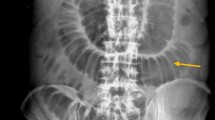Abstract
Duodenal lipoma is a very rare entity with limited case reports present in literature. But duodenal ampullary lipomas are even more rare in nature. Owing to the recent advances in endoscopy and modern imaging techniques, more cases are being diagnosed and treated. However, challenge lies in performing a less invasive and least morbid procedures to treat them surgically in such complex location of tumour. To study the diagnosis and treatment of duodenal ampullary lipoma in a young male patient and challenges faced during surgical management. A 15-year-old young boy presented to us with complaints of intermittent upper gastrointestinal bleed and jaundice since last 2 months. At admission, his serum haemoglobin was 3 g% for which he was transfused 3 units of packed blood cells for optimization. On further evaluation, CT scan abdomen revealed 71 × 49 mm large heterogeneous mass in D3 segment of duodenum causing duodeno-duodenal intussusception involving D1 and D2 segment along with ampullary region with mass being the lead point. There was compression of CBD with dilatation measuring 11 mm in diameter and mild IHBR dilatation. UGIE revealed narrowing at D1–D2 junction due to polypoidal lesion with overlying smooth mucosa with no active bleeding point identified. His blood parameters were normal except for low haemoglobin (before blood transfusion) and total serum bilirubin of 2.3 mg/dl.He was optimized for surgery and underwent exploratory laparotomy with duodenotomy at D2 with mass excision of 7 × 5 cm sessile polyp with base over ampulla followed by plastic repair of sphincter of Oddi (pancreas preserving procedure). He was started on oral liquids on POD 3 and was discharged on normal diet by POD 7 with an uneventful recovery. Result of histopathological report revealed, on gross cut section, the presence of mass of 7 × 5 × 3 cm size with smooth mucosa and fibrofatty tissue. On microscopic examination, diagnosis of submucosal lipomatous polyp was made. Our case report indicated duodenal ampullary lipoma is extremely rare entity. The symptoms are nonspecific and CT scan abdomen is the first investigation of choice for diagnosis. The treatment depends on the patient’s condition as well as the size and position of the tumour. In our case report, the tumour base was exactly at the level of ampulla where we performed complex procedure of local excision of mass with sphincteroplasty avoiding major Whipple procedure for such benign condition. It provided rapid postoperative recovery to the patient.


Similar content being viewed by others
Data Availability
Not applicable.
References
Knight CD, Black BM (1951) Duodenojejunal intussusception due to lipoma: report of a case. Proc Staff Meet Mayo Clin 26:320–323
Blanchet MC, Arnal E, Paparel P, Grima F, Voiglio EJ, Caillot JL (2003) Obstructive duodenal lipoma successfully treated by endoscopic polypectomy. Gastrointest Endosc 58(6):938–939
In Ho J, Young HM (2010) Safe techniques for endoscopic resection of gastrointestinal lipomas. Gastric Cancer 10(4):254–258
Tung CF, Chow WK, Peng YC, Chen GH, Yang DY, Kwan PC (2001) Bleeding duodenal lipoma successfully treated with endoscopic polypectomy. Gastrointest Endosc 54(1):116–117
Wichendu PN, Dodiyi-Manuel A (2013) Gastric outlet obstruction from duodenal lipoma in an adult. Niger J Surg 19(2):79–81
Lundell L, Hyltander A, Liedman B (2002) Pancreas-sparing duodenectomy: technique and indications. Eur J Surg 168(2):74–77
Funding
No funds, grants, or other support was received.
Author information
Authors and Affiliations
Corresponding author
Ethics declarations
Ethical Approval
Ethical approval was waived by the local Ethics Committee as it is part of routine care.
Informed Consent
Taken from the patient.
Consent for Publication
Not applicable.
Competing Interests
The authors declare no competing interests.
Additional information
Publisher's Note
Springer Nature remains neutral with regard to jurisdictional claims in published maps and institutional affiliations.
Rights and permissions
Springer Nature or its licensor (e.g. a society or other partner) holds exclusive rights to this article under a publishing agreement with the author(s) or other rightsholder(s); author self-archiving of the accepted manuscript version of this article is solely governed by the terms of such publishing agreement and applicable law.
About this article
Cite this article
Sahni, M., Daga, R., Jangir, N. et al. Management of a Rare Challenging Case of Duodenal Ampullary Lipoma. Indian J Surg Oncol 15 (Suppl 2), 322–324 (2024). https://doi.org/10.1007/s13193-023-01857-y
Received:
Accepted:
Published:
Issue Date:
DOI: https://doi.org/10.1007/s13193-023-01857-y




